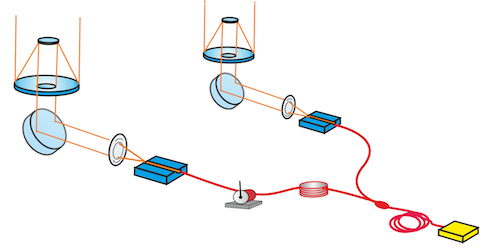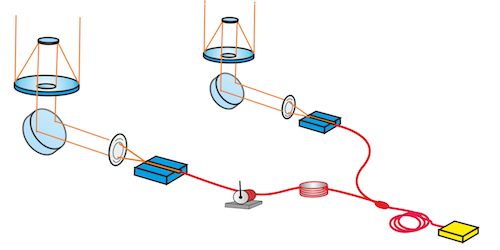Sharper Vision for Infrared Telescopes
The Universe can appear very different when observed with infrared-sensitive “eyes.” Infrared telescopes can peer through intergalactic clouds that block visible light, or see cold objects such as forming exoplanets. However, the poorer performance of detectors as well as the thermal light emitted by mirrors at these wavelengths make infrared observations more challenging than visible ones. Now, the work of Pascaline Darré at the University of Limoges, France, and co-workers suggests that a technique to convert infrared light to visible frequencies may boost the sensitivity of infrared telescopes.
The conversion scheme collects astronomical infrared light with a telescope and sends it into a waveguide made of a nonlinear optical material. There, the infrared light is mixed with laser light and converted to visible light through a process known as sum-frequency generation. The visible light is then directed through optical fibers onto detectors. Previous laboratory experiments by the same authors showed that the method has the potential of reducing detection noise.
The new work demonstrates that the technique could benefit a real telescope—the CHARA array of telescopes near Los Angeles. Telescopes like CHARA are based on interferometry: they build up images by mixing the signals coming from each telescope, achieving the same angular resolution as telescopes with the size of the entire array. Applying their conversion scheme to two of CHARA’s telescopes, Darré and her colleagues collected 1.5- m light from a star in the Ursa Major constellation and converted it to red light. They showed that the signals from the two telescopes generated interference fringes on a detector, that is, the conversion process preserved the light coherence that is necessary for an interferometric array to work.
This research is published in Physical Review Letters.
–Matteo Rini
Matteo Rini is the Deputy Editor of Physics.





